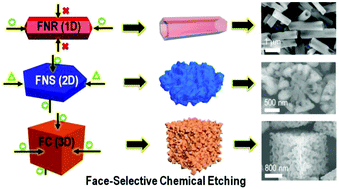Post-assembly dimension-dependent face-selective etching of fullerene crystals†
Abstract
Herein, we report the face-selective chemical etching of fullerene crystals in solvent under ambient conditions of temperature and pressure. First, fullerene C60 nanorods (FNRs), fullerene C60 nanosheets (FNSs) and fullerene C70 cubes (FCs) were prepared using ultrasound assisted liquid–liquid interfacial precipitation (ULLIP). Chemical etching of these crystals was then performed using ethylene diamine (EDA), which results in selective etching at the ends of FNRs forming hollow-structured fullerene nanotubes. For two dimensional FNSs, etching occurs mostly at the upper and lower surfaces of the sheets with partial etching at the edges. For three dimensional FCs, etching occurs on all faces of the cubes leading to the formation of objects with a gyroid-like morphology. In addition to the excellent water dispersibility due to EDA functionalization, chemically etched fullerene nanostructures showed excellent vapor sensing performance selective for acid vapors (formic or acetic acids) over aromatic vapors (benzene or toluene). In contrast to the established yet costly lithography techniques used to make microstructures, this is a simple and scalable solution process, and it presents a low-cost strategy for which we have coined the term ‘beaker lithography’ for the construction of hollow fullerene nanostructures.



 Please wait while we load your content...
Please wait while we load your content...